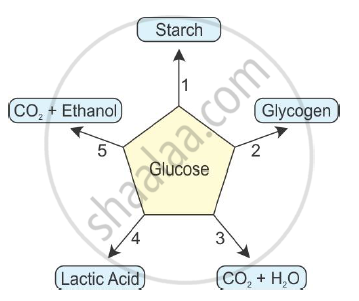Advertisements
Advertisements
प्रश्न
Describe the exchange of gases which takes place in the leaves of a plant
(a) during daytime, and (b) at night.
उत्तर
(a) During the daytime, the leaves use some of the oxygen produced through photosynthesis for respiration. For photosynthesis, the leaves not only use the carbon dioxide produced through respiration but some carbon dioxide is also taken in from the air. Thus, during the daytime, oxygen diffuses out and carbon dioxide diffuses in.
(b) At night, as photosynthesis does not takes place, oxygen is not produced. Thus, oxygen from the air diffuses into the leaves to carry out respiration. And carbon dioxide produced by respiration diffuses out into the air. So, at night, oxygen diffuses in and carbon dioxide diffuses out.
APPEARS IN
संबंधित प्रश्न
Given below are the end products of different reactions involving glucose.

Write the reaction number in front of the following:
(i) Anaerobic reaction =
(ii) Reaction in the human muscles =
(iii) Aerobic respiration =
(iv) Reaction in the plant cells =
(v) Reaction in the liver
What organs are attached to the two bronchi?
What type of respiration takes place in human muscles during vigorous physical exercise? Give reason for your answer
What is meant by aquatic animals and terrestrial animals?
Why is the rate of breathing in aquatic organisms much faster than in terrestrial organisms?
Which of the following is correct for the process of anaerobic respiration?
| Carbon dioxide always produced | A lot of energy released | |
| (a) | No | Yes |
| (b) | No | No |
| (c) | Yes | No |
| (d) | Yes | Yes |
Lack of oxygen in muscles often leads to cramps in the legs of sprinters. This is due to the conversion of pyruvate to:
During the deficiency of oxygen in tissues of human beings, pyruvic acid is converted into lactic acid in:
An organism X having breathing organs A lives on land. When organism X goes underwater, it cannot survive for a long time unless carrying an oxygen cylinder. On the other hand, the organism Y having breathing organs B always lives in water and if taken out of the water, it dies after a short while. A third organism Z having breathing organs C and D which lives on the banks of ponds, lakes, and rivers can survive on land as well as in water equally well.
(a) What could organism X be? Name the breathing organs A.
(b) What could organism Y be? Name the breathing organs B.
(c) What could organism Z be? Name the breathing organs C and D.
(d) Out of X, Y, and Z, which organism is (i) amphibian, (ii) aquatic, and (iii)
terrestrial?
What happens to the glucose which enters the nephron tubule alongwith the filtrate?
In the lungs what substance is removed from the body?
Answer the following in detail.
Explain the process of Cellular Respiration.
Name the body structure concerned with the given functional activity:
Combines with the oxygen in the lungs.
Given below is an example of certain structure and its special functional activity:
"Kidney and excretion".
Fill in the blanks on a similar pattern.
Epiglottis and _____________.
Given below is an example of certain structure and its special functional activity:
"Kidney and excretion".
Fill in the blanks on a similar pattern.
Diaphragm and _____________.
Give suitable explanation for the following :
Why does a person feel breathlessness at higher altitudes?
Give Suitable Explanation for the Following :
Why do you shiver and why do your teeth chatter when it is very cold in winter?
Given below is an overall chemical reaction of a certain process:
C6H12O6→LacticAcid+2ATP+Heat enengy
Name one tissue in which this reaction occur.
Complete the analogy.
Transport of CO2 by plasma : 7% :: Transport of CO2 by bicarbonate ions: ____________.
Name the energy currency in the living organisms. When and where is it produced?
